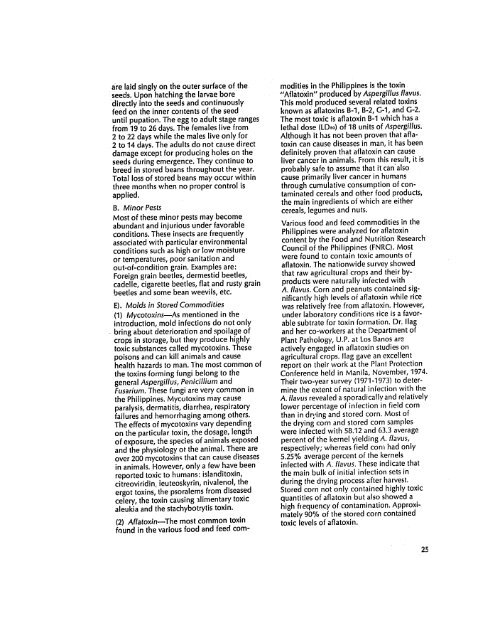I AR Pest control - USAid
I AR Pest control - USAid
I AR Pest control - USAid
Create successful ePaper yourself
Turn your PDF publications into a flip-book with our unique Google optimized e-Paper software.
are laid singly on the outer surface of the<br />
seeds. Upon hatching the larvae bore<br />
directly into the seeds and continuously<br />
feed on the inner contents of the seed<br />
until pupation. The egg to adult stage ranges<br />
from 19 to 26 days. The females live from<br />
2 to 22 days while the males live only for<br />
2 to 14 days. The adults do not cause direct<br />
damage except for producing holes on the<br />
seeds during emergence. They continue to<br />
breed in stored beans throughout the year.<br />
Total loss of stored beans may occur within<br />
three months when no proper <strong>control</strong> is<br />
applied,<br />
B. Minor <strong>Pest</strong>s<br />
Most of these minor pests may become<br />
abundant and injurious under favorable<br />
conditions. These insects are frequently<br />
associated with particular environmental<br />
conditions such as high or low moisture<br />
or temperatures, poor sanitation and<br />
out-of-condition grain. Examples are:<br />
Foreign grain beetles, dermestid beetles,<br />
cadelle, cigarette beetles, flat and rusty grain<br />
beetles and some bean weevils, etc.<br />
E). Molds in Stored Commodities<br />
(1) Mycotoxins-As mentioned in the<br />
introduction, mold infections do not only<br />
bring about deterioration and spoilage of<br />
crops in storage, but they produce highly<br />
toxic substances called mycotoxins. These<br />
poisons and can kill animals and cause<br />
health hazards to man. The most common of<br />
the toxins forming fungi belong to the<br />
general Aspergillus, Penicillium and<br />
Fusarium. These fungi are very common in<br />
the Philippines. Mycotoxins may cause<br />
paralysis, dermatitis, diarrhea, respiratory<br />
failures and hemorrhaging among others.<br />
The effects of mycotoxins vary depending<br />
on the particular toxin, the dosage, length<br />
of exposure, the species of animals exposed<br />
and the physiology ot the animal. There are<br />
over 200 mycotoxin- that can cause diseases<br />
in animals. However, only a few have been<br />
reported toxic to humans: islanditoxin,<br />
citreoviridin, ieuteoskyrin, nivalenol, the<br />
ergot toxins, the psoralems from diseased<br />
celery, the toxin causing -limentary toxic<br />
aleukia and the stachybotrytis toxin,<br />
(2) Aflatoxin-The most common toxin <br />
found in the various food and feed cornmodities<br />
in the Philippines is the toxin<br />
"Aflatoxin" produced by Aspergillus flavus.<br />
This mold produced several related toxins<br />
known as aflatoxins B-1, B-2, G-1, and G-2.<br />
The most toxic is aflatoxin B-1 which has a<br />
lethal dose (LD.o) of 18 units of Aspergillus.<br />
Although it has not been proven that aflatoxin<br />
can cause diseases in man, it has been<br />
definitely proven that aflatoxin can cause<br />
liver cancer in animals. From this result, it is<br />
probably safe to assume that it can' also<br />
cause primarily liver cancer in humans<br />
through cumulative consumption of contaminated<br />
cereals and other food products,<br />
the cras main eue ingredients n of us which are either<br />
cereals, legumes and nuts.<br />
Various food and feed commodities in the<br />
Philippines were analyzed for aflatoxin<br />
content by the Food and Nutrition Research<br />
Council of the Philippines (FNRC). Most<br />
were found to contain toxic amounts of<br />
aflatoxin. The nationwide survey showed<br />
that raw agricultural crops and their byproducts<br />
were naturally infected with<br />
A. flavus. Corn and peanuts contained significantly<br />
high levels of aflatoxin while rice<br />
was relatively free from aflatoxin. However,<br />
under laboratory conditions rice is afavorable<br />
subtrate for toxin formation. Dr. Ilag<br />
and her co-workers at the Department of<br />
Plant Pathology, U.P. at Los Banos are<br />
actively engaged in aflatoxin studies on<br />
agricultural crops. Ilag gave an excellent<br />
report on their work at the Plant Protection<br />
Conference held in Manila, November, 1974.<br />
Their two-year survey (1971-1973) to determine<br />
the extent of natural infection with the<br />
A. flavus revealed asporadically and relatively<br />
lower percentage of infection in field corn<br />
than in drying and stored corn. Most of<br />
the drying corn and stored corn samples<br />
were infected with 58.12 and 63.3 average<br />
percent of the kernel yielding A. flavus,<br />
respectively; whereas field corn had only<br />
5.25% average percent of the kernels<br />
infected with A. flavus. These indicate that<br />
the main bulk of initial infection sets in<br />
during the drying process after harvest.<br />
Stored corn not only contained highly toxic<br />
quantities of aflatoxin but also showed a<br />
high frequency of contamination. Approximately<br />
90% of the stored corn contained<br />
toxic levels of aflatoxin.<br />
25

















